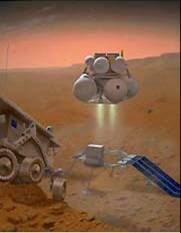Planetary Protection: Protecting the Universe from the Scum of the Earth.
And Vice-Versa
Jason Kastner, PhD
Wednesday, April 25 2007, 7 PM
CLU - Richter Hall Ahmanson Science Building
 Planetary protection is the term given to the practice of protecting solar system bodies (i.e., planets, moons, comets, and asteroids) from contamination by Earth life, and protecting Earth from possible life forms that may be returned from other solar system bodies. Planetary protection is the term given to the practice of protecting solar system bodies (i.e., planets, moons, comets, and asteroids) from contamination by Earth life, and protecting Earth from possible life forms that may be returned from other solar system bodies.
Planetary protection is essential for several important reasons: to preserve our ability to study other worlds as they exist in their natural states; to avoid contamination that would obscure our ability to find life elsewhere—if it exists; and to ensure that we take prudent precautions to protect Earth's biosphere in case it does.
Jason Kastner
NASA Jet Propulsion Laboratory
 Dr. Kastner received his Ph.D. in applied mathematics from Caltech, with a research focus on developmental and computational biology. Prior to joining JPL, Dr. Kastner worked at Northrop Grumman Mission Systems (heritage TRW) and lead the system engineering efforts for a number of situational awareness products for the Defense Department. Dr. Kastner also worked at Wolfram Research (the makers of Mathematica) and consulted for Affymetrix, Affymax, Incyte and Paracel. He is currently the supervisor of the Biotechnology and Planetary Protection group at JPL.
Dr. Kastner received his Ph.D. in applied mathematics from Caltech, with a research focus on developmental and computational biology. Prior to joining JPL, Dr. Kastner worked at Northrop Grumman Mission Systems (heritage TRW) and lead the system engineering efforts for a number of situational awareness products for the Defense Department. Dr. Kastner also worked at Wolfram Research (the makers of Mathematica) and consulted for Affymetrix, Affymax, Incyte and Paracel. He is currently the supervisor of the Biotechnology and Planetary Protection group at JPL.
|

 Planetary protection is the term given to the practice of protecting solar system bodies (i.e., planets, moons, comets, and asteroids) from contamination by Earth life, and protecting Earth from possible life forms that may be returned from other solar system bodies.
Planetary protection is the term given to the practice of protecting solar system bodies (i.e., planets, moons, comets, and asteroids) from contamination by Earth life, and protecting Earth from possible life forms that may be returned from other solar system bodies. Dr. Kastner received his Ph.D. in applied mathematics from Caltech, with a research focus on developmental and computational biology. Prior to joining JPL, Dr. Kastner worked at Northrop Grumman Mission Systems (heritage TRW) and lead the system engineering efforts for a number of situational awareness products for the Defense Department. Dr. Kastner also worked at Wolfram Research (the makers of Mathematica) and consulted for Affymetrix, Affymax, Incyte and Paracel. He is currently the supervisor of the Biotechnology and Planetary Protection group at JPL.
Dr. Kastner received his Ph.D. in applied mathematics from Caltech, with a research focus on developmental and computational biology. Prior to joining JPL, Dr. Kastner worked at Northrop Grumman Mission Systems (heritage TRW) and lead the system engineering efforts for a number of situational awareness products for the Defense Department. Dr. Kastner also worked at Wolfram Research (the makers of Mathematica) and consulted for Affymetrix, Affymax, Incyte and Paracel. He is currently the supervisor of the Biotechnology and Planetary Protection group at JPL.